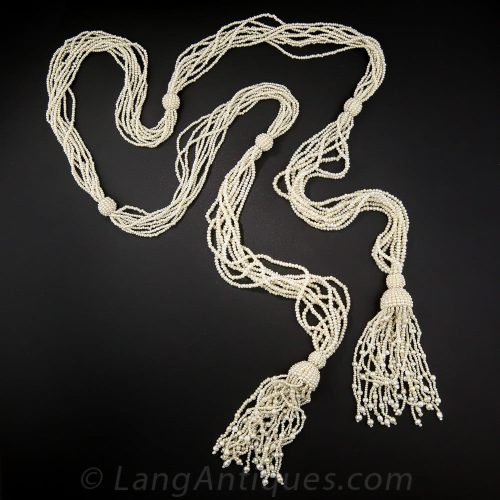
Seed pearls are very small; less than a one-quarter grain in weight, smaller than 2mm in size and off-round in shape. Historically they occurred naturally and were used as a decorative border, as tiny accents in small patterns, or in larger clusters woven together to make up an entire piece of jewelry. A nineteenth-century obsession with pearls is evident in the profusion of tiny seed pearls on every type of jewelry imaginable. Imported from India and China, seed pearls were strung on white horsehair or silk and sewn to mother-of-pearl templates to create elaborate designs. The typical seed pearl parure was composed of a pair of bracelets, a brooch, a pair (or two) of earrings, necklace, ring, and an aigrette. Considered chaste and elegant, these amazingly elaborate seed pearl parures were deemed to be an appropriate bridal gift and always apropos in the ballroom Famously, Mary Todd Lincoln received a Tiffany & Co. seed pearl parure from her husband to wear at his inauguration.
Gemological Information for Seed Pearls
| Color: | White, Pink, Cream and Black |
| Crystal Structure: | Crystalline Layers |
| Refractive Index: | 1.53 to 1.685 |
| Durability: | Good to Fair, Can be Scratched, Will Crush. |
| Hardness: | 2.5 to 4.5 |
| Family: | Pearls |
| Similar Stones: | Cultured Pearls, Imitation Pearls |
| Treatments: | Bleaching and Dyeing |
| Country of Origin: | Sri Lanka, Australia, Central America |
Seed Pearl Care
| Ultrasonic Cleaning: | Never |
| Steam Cleaning: | Never |
| Warm Soapy Water: | Safe - Dry String Before Wearing |
| Chemical Attack: | Attacked by Acids and Perfume |
| Light Sensitivity: | Stable |
| Heat Sensitivity: | Will Burn with Extreme Heat |
Sources
- Gem Reference Guide, Los Angeles: Gemological Institute of America, 1988. Pp. 169-171.
- Newman, Harold. An Illustrated Dictionary of Jewelry, New York: Thames and Hudson, 1981. Pp. 274.
- Schumann, Walter. Gemstones of the World, New York: Sterling Publishing, Co., 1977. Pp. 222-231.